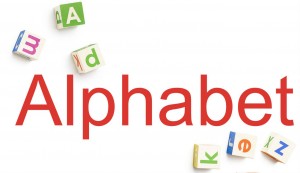 By Gary Smith
By Gary Smith
How can the Google tax row help us understand Alphabet’s growth?
 On the morning of 2 February, an announcement from Google’s parent company, Alphabet confirmed better than expected annual earnings. Of greater significance, not least from a psychological point of view, was the revised market capitalisation valuation showing that the tech giant was now the most valuable company in the world; an honour that was previously held by Apple.
On the morning of 2 February, an announcement from Google’s parent company, Alphabet confirmed better than expected annual earnings. Of greater significance, not least from a psychological point of view, was the revised market capitalisation valuation showing that the tech giant was now the most valuable company in the world; an honour that was previously held by Apple.
How did Google get here? What does the near future hold? Casting an eye on Alphabet is crucial if you have this particular company in your sights as a trader. But more widely, there are lessons to be learnt from Google’s performance if you are focusing on the tech sector as a whole.
Why is Alphabet such a big deal to both the taxman and to traders?
Shortly before the news of Alphabet’s crown-stealing market capitalisation was hitting the financial news, Google on this side of the Atlantic was dominating domestic news, albeit for slightly different reasons. HMRC had apparently reached a deal with the multi-national for a contribution towards tax on previous years’ profits. A figure of £130 million was quoted, although details were sketchy and the principle of taxpayer confidentiality meant little was forthcoming on what the figure actually related to.
The row over Google’s tax position highlights two trends relating to the company – and to a large extent, to the tech sector as a whole. These trends also mirror the way in which the sector is viewed by traders and investors has also changed over recent years.
The first point relates to the company’s revenue growth over the last decade, and especially over the last two to three years. For tax purposes, the formula previously agreed for calculating the company’s profits involves applying a markup to its running costs: because of the intricacies of the company’s structure, taxes were not previously paid on profits generated from selling to UK advertisers. But at the time when this was agreed (around 2005), Google was big – but not that big. Revenue worldwide was around the $6bn mark. Fast forward to 2015 and end of financial year global revenue was $74.5 bn. UK revenue alone for 2014 was reportedly $6.5bn.
Back in the early 2000s, while it was recognised that tech was a growth sector, few would have predicted the extent to which the likes of Google, Facebook and Microsoft would outperform the rest of the market by such a wide margin. Remember also that the markets had been bitten by the first dot-com crash at the turn of the century. The focus for HMRC a decade or so ago was on attracting big tech names to have a physical presence on our shores to help develop the wider sector: something very different to regarding them individually as Corporation Tax cash cows. Similarly, for an investor or trader a decade ago, few would have afforded Google blue-chip, solid performing and low-risk status within their portfolios. They probably would now.
The second point relates to why state treasuries are honing in on tech at this particular time. This can be answered, in part at least, by the fact that this sector looks attractive because others are faring so badly. Last year, performance within the financial and industrial sectors was sluggish, whereas for energy and materials it was decidedly grim. As tax revenue from the ‘usual suspects’ such as oil and the City is relatively sparse, the taxman has to look for fresh hunting grounds.
Investor and trader behaviour can be seen in the same light. A flight from energy, industrials and minerals means that investors have to look elsewhere. An interest rate rise seems to have been kicked into the long grass, meaning that cash investments will continue to remain unattractive. Companies such as Alphabet (which has seen growth in its stock price of just shy of 30% in the year to 5 Feb) start to look even more attractive in this context.
So where next for Alphabet stock?
The optimist’s view
Google’s sheer size means it is able to absorb losses from experimental “moonshot” initiatives and still stay profitable. Seven of the products it owns have more than a billion customers: Search, Maps, YouTube, Chrome, Android, Google Play and Gmail.
But in the tech world, user numbers do not automatically equate to profit. Twitter is a good example of this: since flotation, the company has always been keen to emphasise the growth of its user base over advertising revenue. However, when the company announced recently that its number of users had stalled, investors swiftly lost interest and its share price nose dived. Google, by contrast, relies on its well-established and still growing paid search business to rely on as the bread-and-butter money maker. With no sign of any serious competition to this profitable paid search function, the company looks fundamentally strong.
Analysts seem to agree. The current average annual price target based on the views of 43 analysts is for 15% share price growth above current levels.
The pessimist’s view
It’s not so much that Alphabet is in danger of seeing a price collapse. There is however, a general principle which suggests that once a company reaches a certain size and market reach, finding new revenue streams becomes tougher. Year-on-year, it then becomes tougher to meet growth expectations, which can in itself cause trader and investor confidence to wobble.
The bigger risk, based on the performance of tech stocks over the last few weeks, is that Alphabet gets caught up in a general slide. Facebook, Amazon, Netflix, Twitter and Google have all witnessed a slide recently. It remains to be seen whether this is a temporary correction or else an early indication that investors in 2016 will take a more bearish attitude to tech.
This is an exciting time to take a position on assets across the tech sector. Read our essential binary options platform reviews to discover the best tools for staying ahead of the game.
 By Gary Smith
By Gary Smith